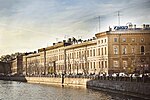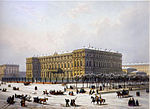Potseluev Bridge
1768 establishments in the Russian EmpireBridges completed in 1738Bridges completed in 1768Bridges completed in 1808Bridges in Saint Petersburg

The Potseluev Bridge (Russian: Поцелуев мост, literally Bridge of Kisses) is a bridge across the Moyka River in Saint Petersburg, Russia. The name of the bridge spurred numerous urban legends. The panoramic view of Saint Isaac's Cathedral that opens from the bridge makes it a popular subject of artists paintings.
Excerpt from the Wikipedia article Potseluev Bridge (License: CC BY-SA 3.0, Authors, Images).Potseluev Bridge
Поцелуев мост, Saint Petersburg
Geographical coordinates (GPS) Address External links Nearby Places Show on map
Geographical coordinates (GPS)
| Latitude | Longitude |
|---|---|
| N 59.928333333333 ° | E 30.295 ° |
Address
Поцелуев мост
Поцелуев мост
190999 Saint Petersburg (Адмиралтейский округ)
Saint Petersburg, Russia
Open on Google Maps









